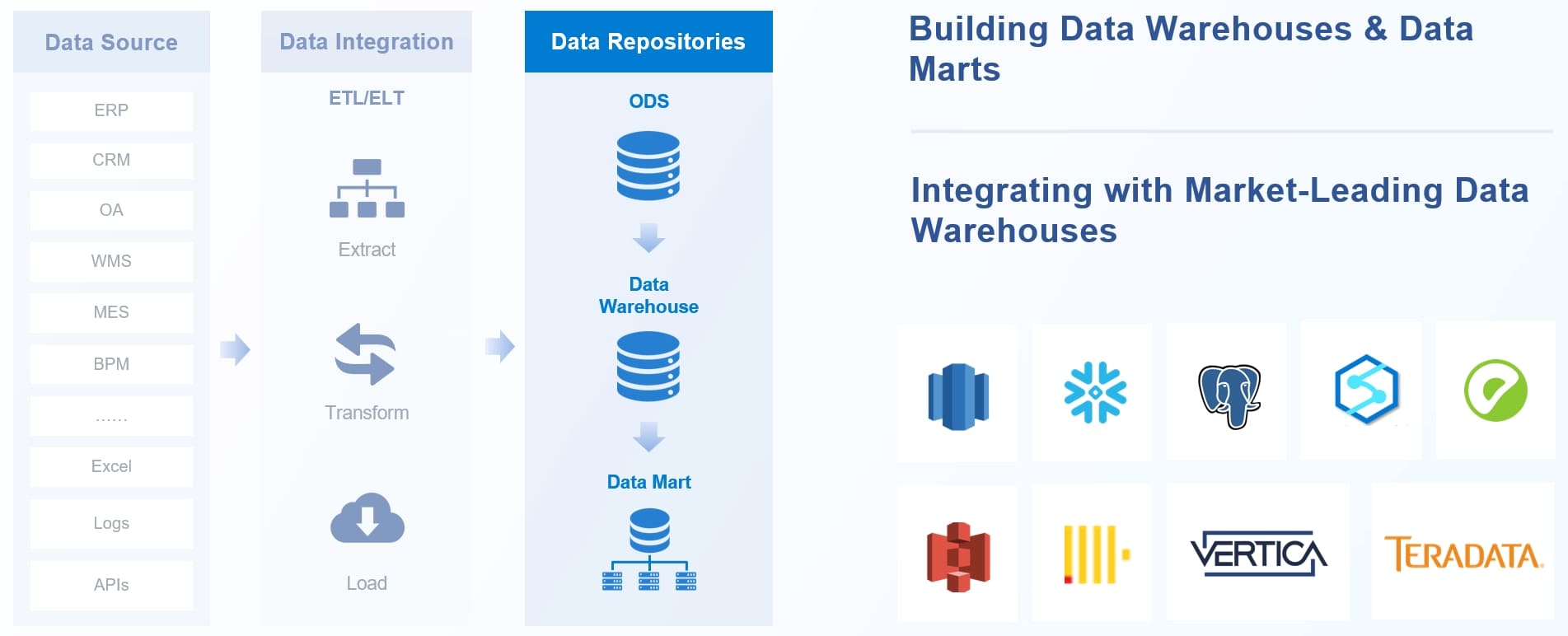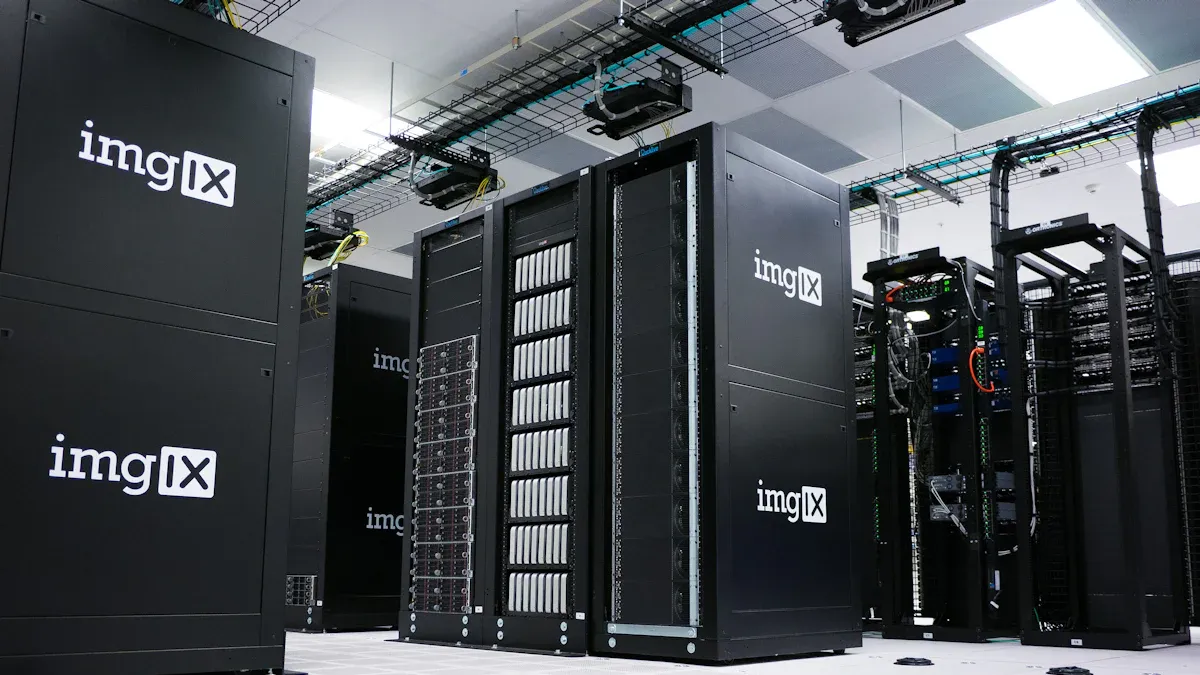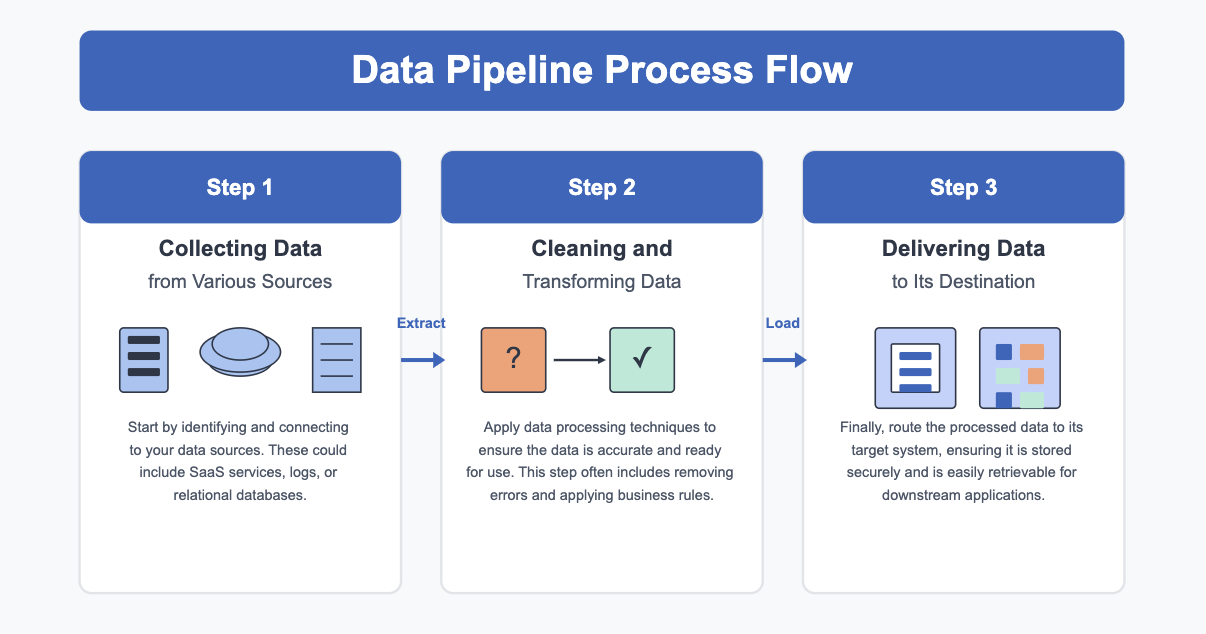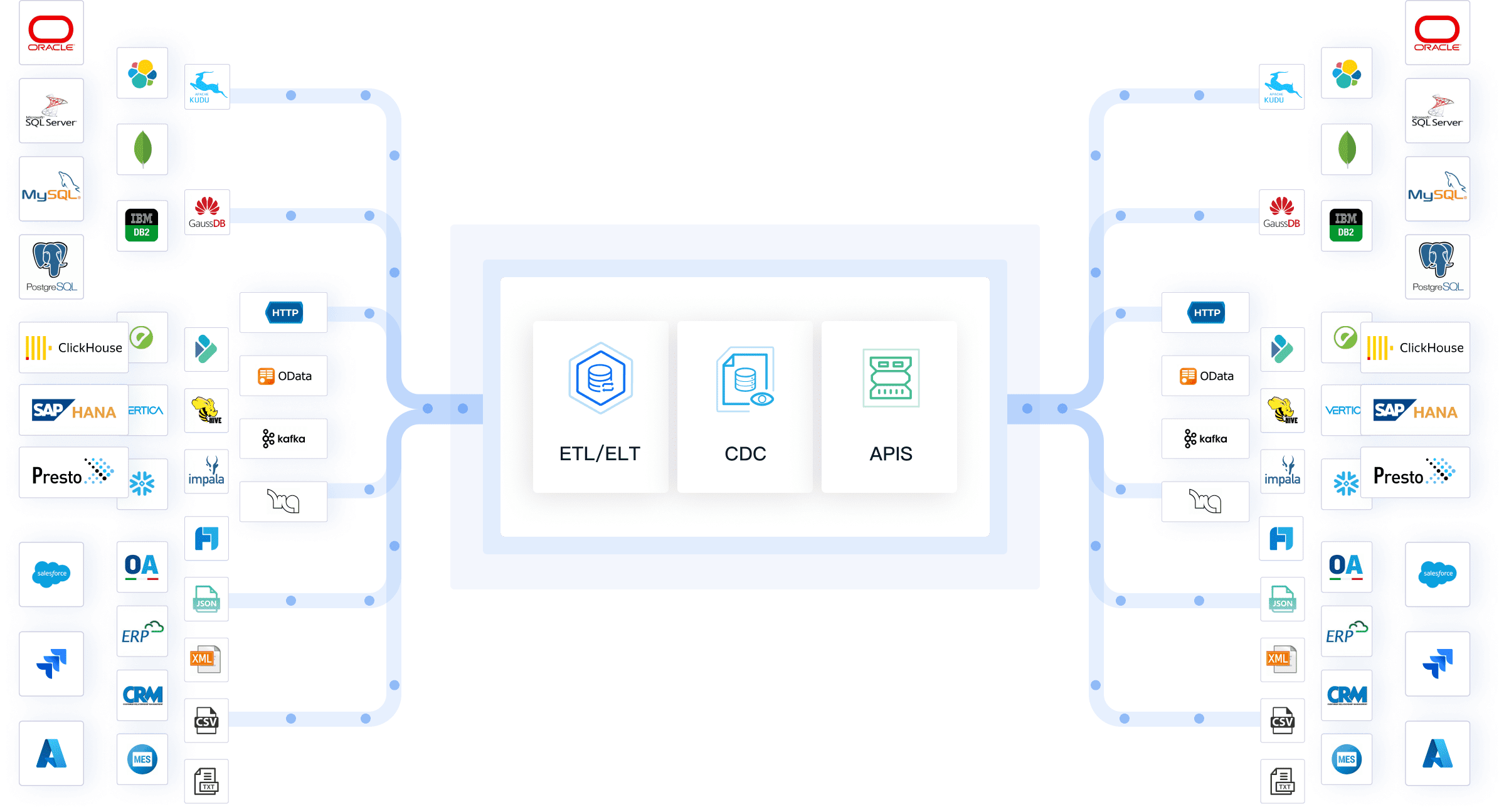You encounter data everywhere—sales numbers, website visits, patient records, and more. Data warehousing concepts help you organize and analyze this information, making sense of it for smarter decisions. Today, over 90% of organizations use data warehousing solutions, with 58% choosing cloud-based options in 2024.
| Metric | Value |
|---|---|
| Global adoption rate | Over 90% |
| Cloud-based deployments | 58% |
| Year of data | 2024 |
Hospitals, banks, and manufacturers rely on data to improve care, detect fraud, and optimize operations. You do not need technical experience to understand these ideas. FineDataLink offers a modern platform that makes integrating and managing data simple for everyone.
Data Warehousing Concepts: Fundamentals

What Is a Data Warehouse?
You can think of a data warehouse as a specialized system that helps you collect, store, and analyze large amounts of data from different sources. Instead of keeping information scattered across many places, a data warehouse brings everything together in one central location. This makes it easier for you to find patterns, answer questions, and make decisions based on facts.
- A data warehouse is a system designed to support business intelligence activities, especially analytics.
- It centralizes and consolidates large amounts of data from multiple sources, enabling valuable business insights.
- A data warehouse, also known as an OLAP system, acts as a repository for data extracted, loaded, and transformed from operational source systems for analysis and reporting.
To help you picture this, imagine a distribution center in logistics. Trucks deliver goods from different factories to the center. Workers sort and organize these goods so stores can quickly get what they need. In the same way, a data warehouse collects data from various departments, organizes it, and makes it easy for you to access and analyze.
A data warehouse follows four foundational principles:
- Subject-oriented: You organize data around key subjects, such as sales, customers, or inventory, instead of by individual transactions.
- Integrated: You combine data from different sources into a single, consistent format.
- Non-volatile: Once you store data in the warehouse, it remains stable and does not change frequently.
- Time-variant: You keep historical data, which allows you to analyze changes and trends over time.
These principles form the core of data warehousing fundamentals and help you understand why a data warehouse is different from regular databases.
Why Data Warehousing Matters
Data warehousing plays a vital role in helping you make better business decisions. When you use a data warehouse, you gain access to organized and reliable information from across your organization. This supports business intelligence and analytics by transforming raw data into structured formats. You can then perform in-depth analysis of your company’s performance.
A data warehouse serves as a central repository that consolidates data from various sources. This is crucial for business intelligence because it allows you to handle complex queries and analytical workloads. You get a consolidated view of your business, which helps you make strategic decisions.
Here are some key benefits of implementing a data warehouse:
| Benefit | Description |
|---|---|
| Enhanced Business Intelligence | Provides data from various sources, enabling informed decision-making. |
| Time Savings | Allows quick access to critical data from a single platform. |
| Improved Data Quality | Standardizes data from multiple sources, ensuring consistency. |
| Historical Intelligence | Stores large amounts of historical data for trend analysis and predictions. |
| Increased Security | Enhances data security, crucial for sensitive information. |
You can see how data warehousing concepts help you save time, improve data quality, and protect your information. By storing historical data, you can also spot trends and make predictions for the future.
Core Data Warehousing Concepts
To understand key data warehousing concepts, you need to look at how a data warehouse supports your daily work. When you use a data warehouse, you can retrieve data efficiently, run complex queries, and integrate with business intelligence tools. This gives you deeper insights and helps you make data-driven decisions.
- Data warehouses enable efficient data retrieval.
- They facilitate complex queries that support informed decision-making.
- Integration with BI tools enhances data-driven insights.
Think of a data warehouse as the backbone of your analytics efforts. It brings together information from sales, marketing, finance, and other departments. You can then use this unified data to answer important questions, such as which products are selling best or where you can cut costs.
By understanding data warehousing fundamentals, you set the stage for mastering more advanced topics. You also prepare yourself to use modern platforms like FineDataLink, which make it easier to build and manage your own data warehouse.

Key Data Warehousing Concepts and Architecture

Data Integration and ETL
You need strong data integration to build an effective data warehouse. Data integration brings together information from many sources, such as databases, cloud storage, and external providers. The ETL process—Extract, Transform, Load—helps you collect raw data, clean and format it, and then load it into your data warehouse. This process ensures that your data warehouse contains accurate and accessible information for analysis.
- Extraction gathers data from different systems.
- Transformation cleans and standardizes data for consistency.
- Loading moves the processed data into your data warehouse.
Modern platforms like FineDataLink simplify data integration with low-code development, automated synchronization, and drag-and-drop operation. You can connect diverse sources and keep your data warehouse updated in real time. FineDataLink also standardizes formats and automates synchronization, which helps you overcome data silos and complex formats.
| Feature | Description |
|---|---|
| Low-Code Development | Create workflows without extensive coding. |
| Automated Data Synchronization | Keep data updated across systems in real time. |
| Seamless Integration | Connect diverse sources for better accessibility. |
| Real-Time Data Integration | Manage large volumes with minimal latency. |

Data Modeling: Star and Snowflake Schemas
Data modeling shapes how you organize information in your data warehouse. The star schema uses a central fact table linked to denormalized dimension tables, making it simple and fast for queries. The snowflake schema connects the fact table to normalized dimension tables, which reduces redundancy but increases complexity.
| Feature | Star Schema | Snowflake Schema |
|---|---|---|
| Structure | Central fact table + denormalized dimension tables | Central fact table + normalized dimension tables |
| Query Performance | Faster; fewer joins | Slower; multiple joins |
| Design Complexity | Simple | Complex |
| Space Usage | More storage | Less storage |
You often choose a star schema for fast dashboards and easy reporting. Snowflake schemas work best when you need structured queries and less data redundancy.
OLAP vs. OLTP
You use a data warehouse for analytical tasks, which is different from transaction processing. OLAP (Online Analytical Processing) supports complex analysis and decision-making. OLTP (Online Transaction Processing) handles daily operations like updates and deletions.
| Feature | OLAP | OLTP |
|---|---|---|
| Focus | Complex analysis for decisions | Simple transactions |
| Data Source | Multi-dimensional schema | Traditional DBMS |
| Processing Time | Slower, read-intensive | Fast, every millisecond counts |
| Availability | Less frequent backups | Frequent backups for integrity |
OLAP lets you explore relationships, trends, and patterns in your data warehouse. You gain advanced analytical capabilities and real-time insights for business intelligence.
Metadata and Data Quality
Metadata describes the structure and context of data in your data warehouse. It helps you understand what each piece of data means and how it relates to other information. Good metadata supports data governance and compliance.
Data quality is essential for reliable analysis. You should profile, cleanse, and validate data to maintain accuracy. Automation and continuous measurement help you keep your data warehouse trustworthy.
Start by profiling data to identify issues, then apply targeted rules for cleansing, standardization, and validation. Implement testing in pipelines, monitor quality metrics, and leverage tools for continuous checks.
| Best Practice | Description |
|---|---|
| Data Quality Management | Ensures accuracy and consistency, preventing financial losses. |
| Continuous Measurement | Maintains quality over time. |
| Automation | Enhances accuracy through automated checks. |
| Collaboration | Supports quality initiatives across roles. |
You build a strong data warehouse by focusing on data integration, data modeling, and data quality. FineDataLink helps you achieve these goals with modern tools and real-time capabilities.

Data Warehousing Concepts vs. Related Systems
Data Warehouse vs. Database
You might wonder how a data warehouse differs from a traditional database. Both store information, but they serve different purposes. A database helps you record and manage daily transactions, such as sales or customer updates. In contrast, a data warehouse supports analysis and reporting by storing large amounts of historical data from multiple sources.
Here is a quick comparison:
| Parameter | Database | Data Warehouse |
|---|---|---|
| Use | Recording data | Analyzing data |
| Processing Methods | OLTP | OLAP |
| Concurrent Users | Thousands | Limited number |
| Use Cases | Small transactions | Complex analysis |
| Downtime | Always available | Some scheduled downtime |
| Optimization | For CRUD operations | For complex analysis |
| Data Type | Real-time detailed data | Summarized historical data |
A database works best for real-time tasks, like processing orders or updating inventory. A data warehouse, on the other hand, helps you analyze trends, create reports, and make business decisions. You use a database for quick access to current data, while you rely on a data warehouse for long-term storage and deep analysis.
Data Warehouse vs. Data Lake
You may also hear about data lakes. A data lake stores raw, unprocessed data in its native format. This makes it flexible and cost-effective, but it often requires expert skills to use. A data warehouse, by contrast, stores structured and cleaned data, making it easier for you to run reports and get reliable answers.
| Feature | Data Warehouse | Data Lake |
|---|---|---|
| Security | More secure | Less secure |
| Cost | More costly | Less expensive |
| Agility | Less agile | More flexible |
| Data Structure | Structured data | Raw and unprocessed data |
| User Accessibility | Easier to use | Requires expert skills |
You should choose a data warehouse if your business needs reliable, structured data for reporting and analysis. If you need to store large volumes of raw data for future exploration, a data lake may be more suitable. When your analysts need quick answers and consistent data, a data warehouse is the better choice.
Tip: Use a data warehouse when you want to consolidate processed data from many sources and need fast, reliable queries for business decisions.
Data Warehouse vs. Data Mart
A data mart is a smaller, more focused version of a data warehouse. You use a data mart for a specific department, such as sales or marketing. A data warehouse covers the entire organization, bringing together data from all departments.
| Aspect | Data Mart | Data Warehouse |
|---|---|---|
| Scope | Department-specific | Enterprise-wide |
| Size | Smaller, often around 1 terabyte | Much larger, up to petabytes |
| Use Case | Departmental analysis and tracking | Comprehensive integration and analytics |
A data mart gives you quick access to targeted data, but it may create silos if not connected to a central data warehouse. A data warehouse provides a single source of truth for your whole organization, supporting complex analysis and governance.
Types, Tools, and Best Practices in Data Warehousing Concepts
On-Premises, Cloud, and Hybrid Data Warehousing
You can choose from several types of data warehouse deployments. Each option fits different business needs and data management strategies. The table below shows the main types:
| Type | Description | Use Cases | Advantages | Disadvantages |
|---|---|---|---|---|
| Cloud | Hosted by third-party providers | SaaS companies, big data processing | Scalability, lower upfront cost | Less control over infrastructure |
| On-Premises | Data stored on-site, full control | Regulated industries, stable data volumes | Complete control, predictable performance | Higher upfront costs, maintenance |
| Hybrid | Combines cloud and on-premises | Transitioning organizations, mixed sensitivity | Flexibility, cost optimization | Complexity in management |
Cloud data warehousing is growing quickly. Many companies now prefer cloud solutions for their data warehouse because they offer scalable infrastructure and real-time processing. On-premises data warehouse systems remain popular in industries with strict data management requirements. Hybrid data warehouse deployments help you balance flexibility and control.
Data Warehousing Tools (Including FineDataLink)
You have many tools to help you build and manage a data warehouse. Popular options include Snowflake, Google BigQuery, Amazon Redshift, Azure Synapse Analytics, Oracle Autonomous Data Warehouse, and Greenplum. These tools offer features like elastic scaling, secure data sharing, and integration with cloud platforms.
| Tool Name | Key Features | Pros | Cons | Pricing Model |
|---|---|---|---|---|
| Snowflake | Elastic scaling, multi-cloud | Highly scalable | Pricing can escalate | Pay-per-second |
| Google BigQuery | Real-time analytics, auto scaling | Serverless, fast | Requires SQL expertise | On-demand or flat-rate |
| Amazon Redshift | Columnar storage, AWS integration | Cost-effective | Complicated setup | Pay-as-you-go |
| Azure Synapse Analytics | Hybrid processing, Azure integration | Unified analytics | Can be costly | Usage-based |
| Oracle Autonomous Data Warehouse | Machine learning, high security | Autonomous operation | Best for Oracle ecosystems | Pay-as-you-go |
| Greenplum | Open-source, parallel processing | Highly scalable | Requires expertise | Free/optional support |
FineDataLink stands out for its low-code platform and drag-and-drop interface. You can connect over 100 data sources and automate data integration tasks. FineDataLink helps you synchronize data in real time and set up APIs quickly. This makes it easier for you to manage your data warehouse and improve data quality.

Best Practices for Beginners
You should follow data warehouse best practices to ensure success. Here are some tips:
- Establish strong data governance policies for data management and security.
- Organize metadata using data dictionaries or catalogs.
- Monitor and optimize performance with indexing and partitioning.
- Design your data warehouse for scalability and future growth.
- Implement security measures like encryption and access control.
- Automate processes to reduce manual errors and improve efficiency.
- Use agile methods for better feedback and transparency.
- Define user roles and involve stakeholders in your data management strategy.
Tip: Start small and scale your data warehouse as your needs grow. Use automation and modern tools like FineDataLink to simplify data integration and improve data quality.

Common Challenges and Solutions
You may face challenges when starting with data warehousing. Common issues include manual data processing, testing difficulties, and data accuracy problems. The table below shows how you can overcome these challenges:
| Challenge | Solution |
|---|---|
| Manual Data Processing | Automate with modern data warehouse solutions |
| Testing | Use integrated testing environments |
| Data Accuracy | Automate tasks to reduce human error |
| Performance | Optimize data ingestion and indexing |
| Complexity for Non-technical Users | Use data catalog solutions |
Real-world examples show the impact of effective data warehouse solutions. BOE Technology Group improved operational efficiency by 50% and reduced inventory costs by 5% after building a unified data warehouse and standardizing metrics. You can achieve similar results by following best practices and using advanced data integration tools.

You explored the fundamentals of data warehousing, including integration, modeling, and quality management. Understanding these concepts helps you build a strong foundation for analytics and business intelligence. FineDataLink offers a user-friendly way to manage your data warehousing projects. To continue your learning, you can:
- Practice SQL queries for data manipulation.
- Study data modeling techniques.
- Focus on data quality and security.
- Plan for scalability and maintain documentation.
These steps will help you start your data warehousing journey with confidence.

Continue Reading About Data Warehousing Concepts
Enterprise Data Integration: A Comprehensive Guide
What is enterprise data and why does it matter for organizations
Understanding Enterprise Data Centers in 2025
Enterprise Data Analytics Explained for Modern Businesses
FAQ

The Author
Howard
Data Management Engineer & Data Research Expert at FanRuan
Related Articles

Data Lakehouse vs Data Warehouse Key Differences Explained
Compare data lakehouse vs data warehouse to understand key differences in data types, storage, analytics, and best use cases for your business needs.
Howard
Nov 19, 2025

Comparing Data Quality Tools for Features and Pricing
Compare data quality tools for features and pricing to find the best fit for your business needs, including integration, scalability, and cost.
Howard
Nov 18, 2025

What to Look for in Data Ingestion Tools for Your Business
Compare data ingestion tools by scalability, integration, security, cost, and user experience to find the best fit for your business needs.
Howard
Nov 18, 2025



